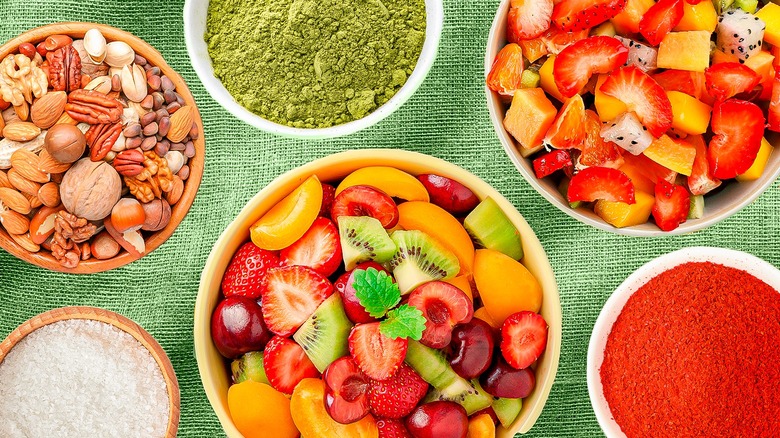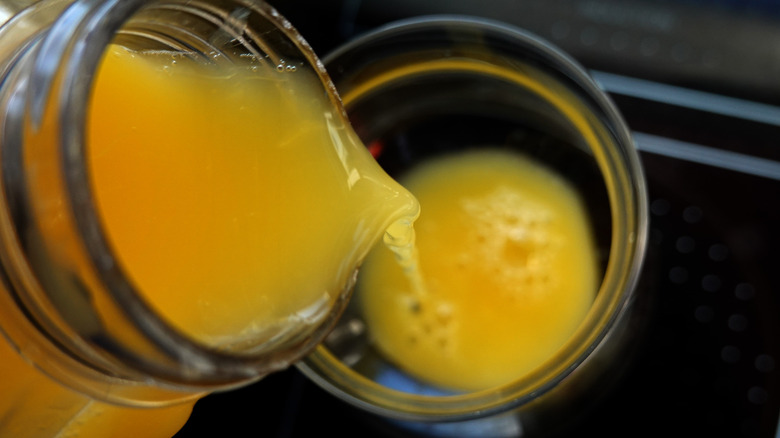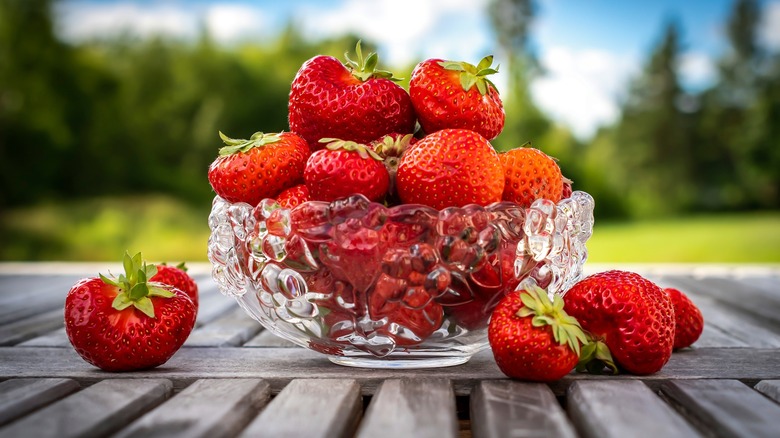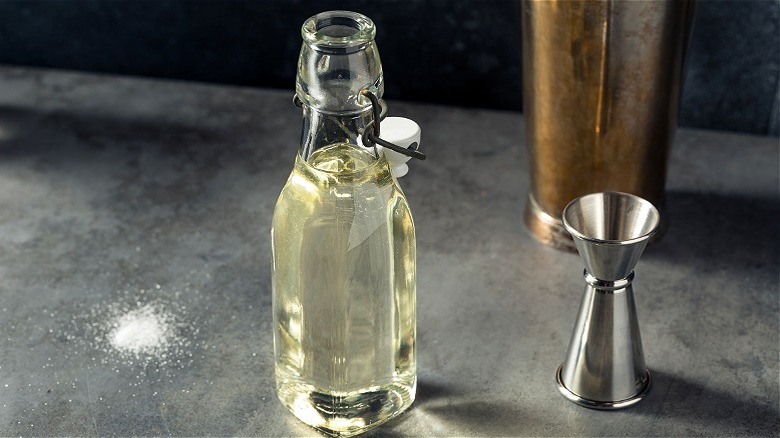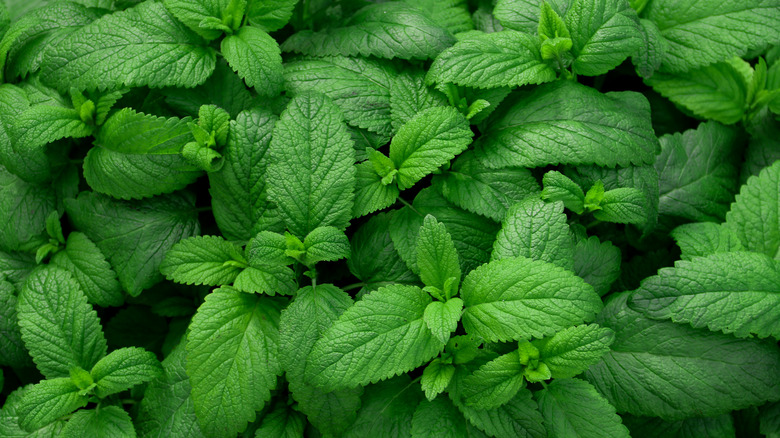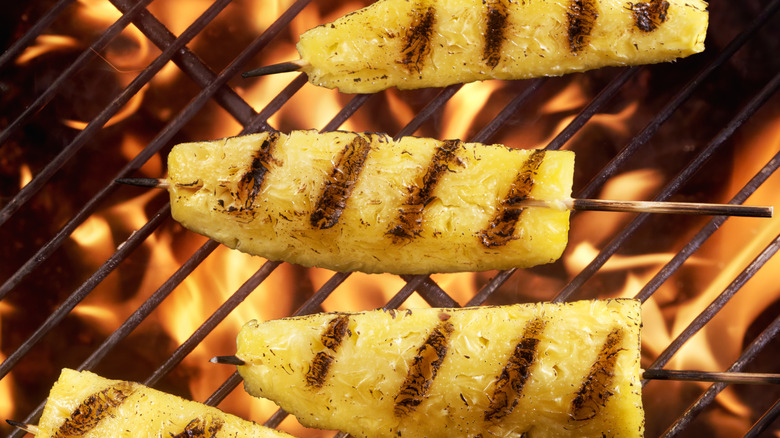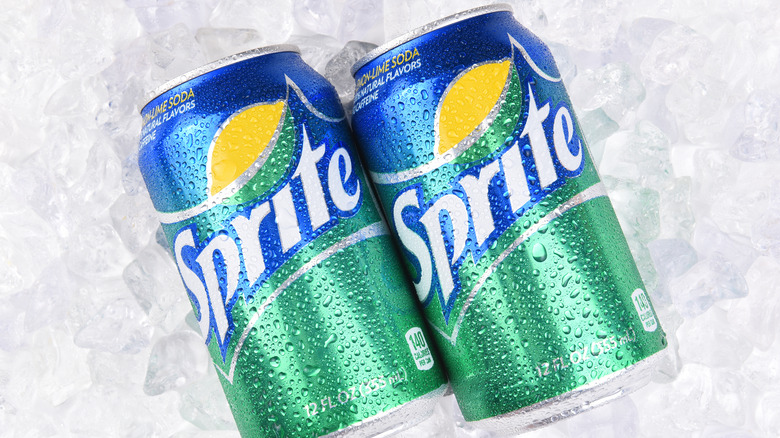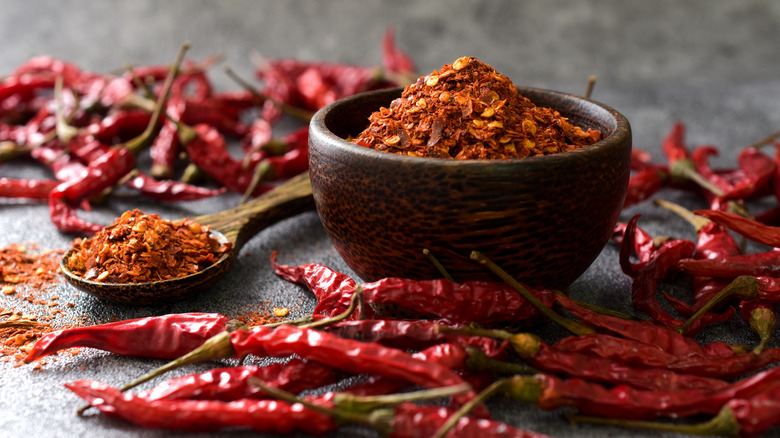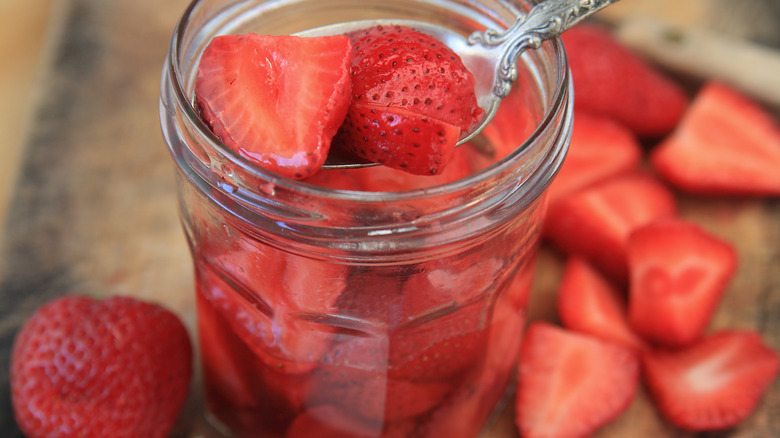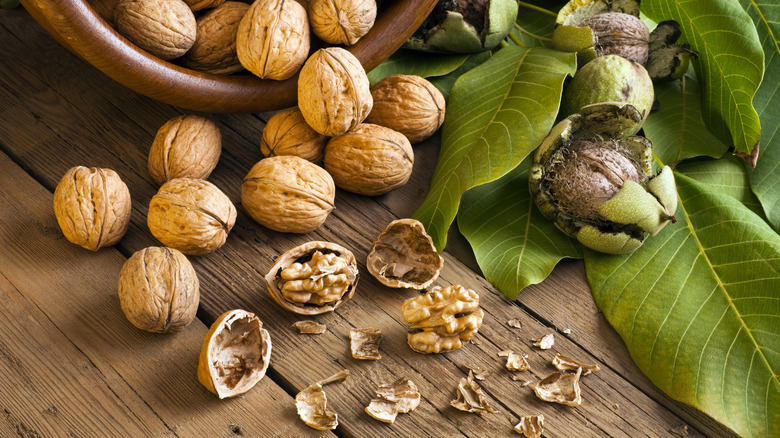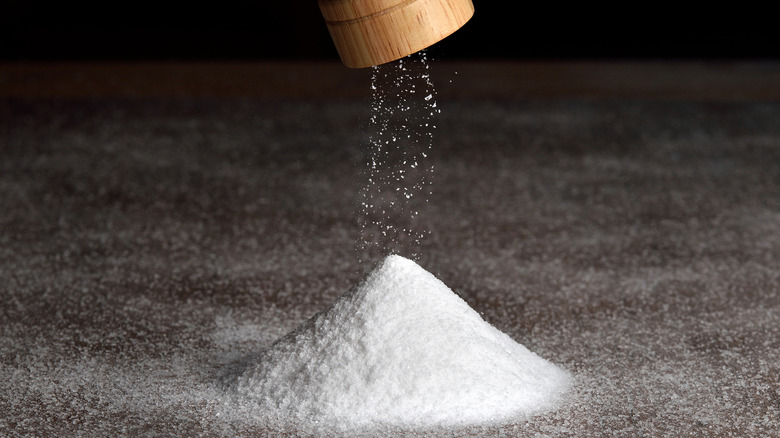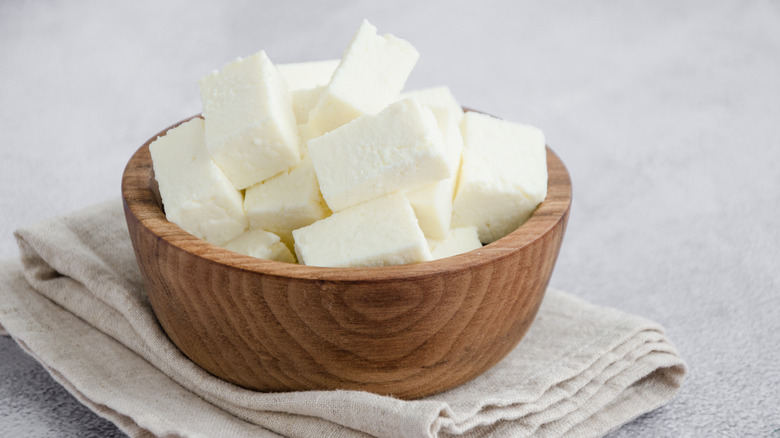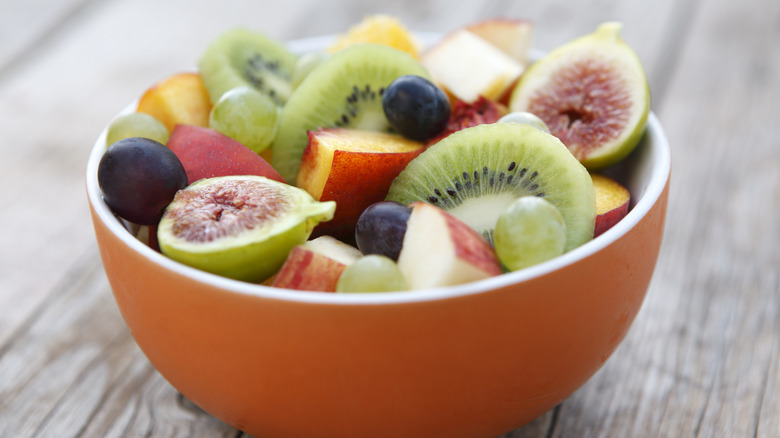14 Ways To Easily Elevate Your Fruit Salad
If you don't hanker to finish a good meal with something sweet, we frankly don't know how you do it. In our books, no dinner is complete until you've capped it off with a sugary delight at the end. For those times when you want something fresh and light for dessert, you really can't do much better than fruit salad. Loosely defined as a medley of chopped fruits, fruit salad is one of the easiest things you can make in the kitchen, and it comes together in mere moments, placing the delightful tastes of whichever fruits you pick front and center.
It's not just simple and delicious, either. With its abundance of fresh fruits, a good fruit salad goes a long way towards delivering your five servings of fruit and vegetables recommended per day by organizations like the National Health Service.
But for all its benefits, fruit salad can be a tricky beast. Too many of us have been faced with fruit salads that feel limp, taste sour, and don't have that zing that we all know and love. How do you make sure your fruit salad is on point? More importantly, how do you take it from being an average dessert to something special? Find out everything you need to know right here.
1. Add a little fruit juice
One of the best ways to amp up your fruit salad is also one of the simplest. Fruit has a nasty habit of browning quickly once it's sliced, thanks to the oxidation process that occurs when their interior enzymes are exposed to air. To prevent this, all you need to do is pour some fruit juice into the mix. Adding fruit juice to your fruit salad recipe will halt the browning process and keep things looking fresh. If you don't have any orange juice on hand, a simple squeeze of lemon or lime will also do the trick.
Adding fruit juice will do more than just keep your salad from changing color, too. Many fruit juices are fairly high in sugar, so adding some will help to boost the overall flavor of the dessert. The acids present in fruit juice will do that too, delivering a necessary counterbalance of sourness that will stop it from becoming too cloying. Plus, since fruit juice is made from fruit, it will do all this within a flavor world that suits the fruit salad perfectly.
2. Use fruits that are in season
Fruit salad is the ultimate in fresh desserts, and few sweet course dishes are likely to feel as vibrant. But if you want your fruit salad to sing, you're far better off opting for plants that are in season. Fresh fruit just tastes better, y'all. When you eat seasonally, the fruit you're buying has to travel shorter distances, meaning that it has less time to lose freshness and flavor, and retains its nutritional value more effectively. This also means that eating seasonal fruits is kinder to the environment, as the food isn't traveling thousands of miles by air, land, and sea to reach your bowl.
If you're making your fruit salads in the depth of summer, your best options for seasonal produce are berries, peaches, kiwis, watermelons, and mangoes. Melon is also a classic summer fruit that goes fantastically in a fruit salad, and which can balance out more acidic flavors. In the fall, apples and pears come into their own, as well as pomegranates and grapes. In wintertime, it can be trickier to find seasonal fruits that work in a fruit salad, but oranges, grapefruits, and even rhubarb might be good options.
3. Brighten it up with a simple syrup
In most situations, fruit salad is sweet enough to be plated up without any additions. But while this salad doesn't necessarily need a dressing, there are times when the fruit you're using is a little too tart and needs some outside help. That's where simple syrup comes in. A mixture of sugar and water, simple syrup provides fruit salad with a burst of sweetness, and gives the whole thing some extra moisture, too.
True to its name, simple syrup is simple to create. To make simple syrup, all you need to do is combine equal parts of granulated sugar and water in a pot. Heat the solution until it starts to boil, then reduce it to a gentle simmer, stirring constantly. Make sure not to splash any on yourself, as syrup solutions can get super hot. Once the sugar has fully incorporated with the water, take it off the boil, and let it cool fully. Finally, either pour it directly onto your fruit salad or pop it in a container in the fridge until you're ready to use it.
4. Add your favorite herbs
While a medley of different fruits can create dynamic flavors, there's no escaping the fact that the base notes of fruits are sweetness and acidity. When you get a lot of those in a bowl, things can start to get a little bit one-dimensional. The flavors can even become slightly heavy.
But one way to lighten up fruit salad in a completely fresh way is to throw in some herbs. Certain herbs can add a floral freshness to fruit salad recipes, making the whole affair even brighter. It's good to keep in mind that some herbs will work better than others. Basil and mint, for instance, deliver a hit of summery sweetness that pairs well with strawberries and mangos. Cilantro, meanwhile, gives peppery warmth. Other herbs like sage or rosemary might be a little more out there, and may not work as well.
When making fruit salad, it's recommended that you opt for fresh herbs over dried ones. Not only will they give a fresher flavor, but they're also softer, meaning you won't end up with a chalky mouthful of dried basil when trying to enjoy your dessert.
5. Create a smoky flavor through grilling
The grill isn't just for savory food. If you're busting out the grill for a summer barbecue, try saving a portion of it for your sweet items. Using the grill will make a fruit salad that can't be beaten.
Certain fruits are perfect for grilling thanks to their high sugar content, which helps to create a caramelized, golden-brown effect on the flesh. By charring fruit, you help it to develop a smoky flavor, which takes your fruit salad from good to great.
Naturally, though, not all fruits are right for grilling. It's best to use fruit that has firm flesh and a large surface area, like pineapple or peaches, rather than smaller items like berries, which are more likely to fall through the slats on your grill. Make sure you're using a fully clean grill, to stop the food absorbing any flavors from other things you might have cooked. Finally, keep an eye on your grilled fruits, not trying to flip them too quickly, as this can just cause them to disintegrate. Allow them to char for a few minutes before flipping them to the other side.
6. Use a can of Sprite
While fruit salad is a perfect dessert for folks trying to eat fresh, you can still enlist help from shelf-stable items. One of those items is something you might not expect, but which will totally make sense, once we explain it. Since launching in 1961, Sprite has been pleasing palettes across the United States and the world with its light and refreshing flavors. Those flavors are lemon and lime, making them perfect for a fruit salad. They help to dress your other fruits in a flavored liquid that boosts the overall taste.
Additionally, using the original Sprite gives extra sugar to your fruit salad, helping to sweeten things up if it's tasting a bit sour or flat. The bubbles in Sprite may also help to brighten up the whole dish, imparting some of that fresh sensation that's so crucial when you drink it. As with any addition to fruit salad, it's best to add a little at a time, to avoid drowning the whole thing in soda and making it taste cloying.
7. Inject some spices
Fruit and spice have been used together for thousands of years, with stewed fruits and holiday dishes combining sweetness with deep aromas. But a lot of the time, combinations of fruit and spice focus on fragrance and depth of flavor over heat. Adding a little bit of fire to fruit, however, is an exciting way to elevate its flavors. In a summery fruit salad, a few dashes of cayenne pepper can make an otherwise boring dish feel bold and confident.
Cayenne pepper provides a gentle, yet insistent heat, and makes a great counterpoint to the sweetness of fruit salad. It also gives the dish a bit of visual interest and a pop of color from its bright-red flecks. With cayenne pepper, though, a little goes a seriously long way, especially in a sweet dish. This spicy chile is roughly twelve times hotter than the average jalapeño. In its dried form, even just a little too much will ruin your meal entirely. The idea is to add piquancy that works with the fruit, not drowns it out.
8. Marinate your fruit
We all know that things taste better when the flavor is well-distributed throughout our food. That's largely the idea behind marination, the act of soaking food in a flavor-packed solution so that it can permeate the foodstuff fully. When we think of marinating, though, we usually think of it in association with savory food, like meats or vegetables. But marination exists for fruit, too. Called macerating, the process is similar to marinating – and it will make your fruit salad taste even better.
The main thing you need to macerate your fruit effectively is time. Once you've chopped up your fruit, simply throw it into a macerating liquid composed of whatever flavors you wish to impart. It can be as simple as a combination of sugar and water, or even your favorite sweet alcohol. Then, leave the fruit to soak for a few hours. As it does so, the flavors of your macerating liquid will work their way into the fruit's flesh, making them taste better, and helping them plump up. Then, drain them, and throw them into your salad. Macerating is also a great way to revive dried fruit like figs or prunes.
9. Throw in a dash of alcohol
In our humble opinion, most foods are improved by the addition of alcohol. That's not just if you're drinking it. Alcohol added to food enhances its taste and its aroma, heightening the natural qualities and flavors of a dish, while also giving it extra taste elements. While you might not think alcohol is a natural fit with fruit salads, adding in a small amount can bring a subtle boost to the food without overpowering it.
Generally, clear alcohols are likely to be best for fruit salads, thanks to their inherent lightness. However, adding a splash of red wine can make a sangria-style fruit salad that's perfect for hot days. If you want your fruit salad to have a little bit of a mojito twist, light rum is the best alcohol to use, with a splash of it combined with some fresh mint making the meal taste like a tropical delight. Light rum has a hint of sweetness to it that combines well with fruit, and is brought out even more if you add a pinch or two of sugar.
Remember, though, unlike other dishes where you add alcohol, you won't be cooking your fruit salad, and so any alcohol you pour in will remain potent. Keep this in mind before you start free pouring, so you don't stop anyone from being able to drive home.
10. Add a few handfuls of nuts
Look, there's no disputing the fact that a classic fruit salad is delicious. But sometimes, even the most well-composed salad can be a little lacking in heft, and you can just end up feeling hungry again 15 minutes afterward. If you want to make your fruit salad into more of a meal — while also adding in some textural elements — toss in a few handfuls of chopped nuts. Nuts elevate your fruit salad in a multitude of ways, but one of the best is that it provides the meal with additional healthy fats and proteins, making the whole thing way more satisfying. The crunch that nuts provide also brings an entirely new dynamic to fruit salad.
Most nuts will work well in a fruit salad, so you can pretty much add anything you have to hand. Pecans and walnuts are particularly good options though, thanks to their slightly softer texture and buttery flavor, which works well with the sharp sweetness of the fruit. Almonds are also a great choice, although make sure to chop them up finely or use slivered almonds, as they can be a little tough and crunchy in their whole form.
11. Find some unique fruits
One of the main reasons why people get bored with fruit salad is because it's a dish that gets a little boring. But that usually occurs because you're making it the same way every time, and probably with the same fruits. What's the logical solution to this? Give those canned peaches a rest. Bring home some new, unique fruits from the store to make your fruit salad stand out.
If you can find them, tropical fruits can provide any fruit salad with a new lease of life. Pitaya (also known as dragon fruit) comes with bright flesh flecked with black seeds. These fruits have a pear-like taste and can give a new twist to your dish. Cherimoya is another fine addition to fruit salad. This piece of produce has a bumpy exterior that looks almost like lizard skin, but inside, it has a delicate, slightly buttery flesh that's almost banana-like in flavor.
Although these fruits may be trickier to find in your local supermarket, specialty food stores or farmers' markets may well stock them. Next time you have guests coming over, make the extra effort and hunt them down, for a more exciting dish.
12. Toss in a pinch of salt
Now, obviously, the main flavor notes in a fruit salad are that of sweetness. But for that sweetness to truly thrive, you'll need to do a little more than dump your fruit into a bowl and hope for the best. That's where a completely different flavor zone comes in, provided by our old friend salt.
It might seem counterproductive to add salt to generate more sweetness, but there's strong scientific reasoning behind it. Salt appears to trigger a nerve response that heightens our receptiveness to sugars, making us taste them more intensely. It's that fascinating biological response that's led people worldwide to embrace sweet-salty combos like salted caramel, and sweet and salty popcorn. It could benefit your fruit salad, too.
Naturally, though, there's a very fine line between salt amping up taste, and turning a formerly sweet meal into something savory. So be sure to add a pinch at a time, allowing it to dissolve fully before doing a taste test. Bear in mind, too, that different salt varieties will have different intensities. Table salt, for example, will usually be saltier and stronger in flavor than flaked sea salt.
13. Mix in some cheese
Fruit and cheese pairings have been enjoyed by diners for longer than we can remember. But for some reason, when it comes to fruit salad, cheese doesn't get a second thought. Well, not anymore. We're here to confirm, once and for all, that the addition of cheese to fruit salad can take it from good to great. The salty, creamy notes from a well-made cheese contrast perfectly with the sharper flavors of fruit. It adds extra protein to the meal, too. You can also cut your cheese shapes to exactly the same size as your fruit pieces for perfect uniformity.
There are many types of cheese out there which work well in fruit salads, but the main rule of thumb is to go for one that's fairly hard and not too pungent. Cubed chunks of cheddar, Swiss, Edam, or gouda can all be good choices — they all hold their shape well amongst the fruit. Slightly softer cheeses, like feta, are also great with fruit. Feta's slightly stronger flavor works well with mellower fruit like grapes or melons. Just be sure not to mix feta in too vigorously, as it has a tendency to crumble and break apart.
14. Roast your fruit in the oven
Cooking fruit can bring untold wonders to its flavor, but it's probably not your first thought when it comes to fruit salad. This dish is the king of raw desserts, after all. Why would you want to cook it?
Well, because it makes things incredibly delicious, that's why. Roasting fruit is an excellent way to heighten certain plants' aromas and tastes. It even creates a burst of flavor in any fruit you have which feels a little lacking. It achieves this by bringing out fruits' sweeter notes, then adding a hint of caramelization, intensifying the flavor experience and giving fruit salad an entirely new dimension.
Firm berries like strawberries are great for roasting, as well as stone fruits like apricots and peaches. It couldn't be easier. Just slice your chosen fruit, arrange it on a baking sheet, and put it in a hot oven set to approximately 375 degrees Fahrenheit. Then, let things cook for roughly 15 minutes or so, checking on the fruit every few minutes to ensure it's not burning. Take the sheet out, let everything cool, and then fling it into a bowl with the other fruit you're using.
